#Edward T Lowe Jr
Explore tagged Tumblr posts
Text
House of Dracula | Episode 439
New Post has been published on https://esonetwork.com/house-of-dracula-episode-439/
House of Dracula | Episode 439

Jim reflects on the last film in the Universal Frankenstein/Dracula Universe – “House of Dracula” starring Lon Chaney Jr, Onslow Stevens, John Carradine, Glenn Strange, Martha O’Driscoll, Lionel Atwill, Jane Adams, and Skelton Knaggs. Dr. Eidelman (Stevens) known for helping those with unique problems, draws the interest of Dracula and Larry Talbott for relief from their respective curses. Throw in the Frankenstein Monster and you have a full set. Find out more about this 1945 classic on this episode MONSTER ATTACK!, The Podcast Dedicated To Old Monster Movies.
#Edward T Lowe#Erle C. Kenton#ESO Network#geek podcast#Geek Talk#Glenn Strange#House of Dracula#Jane Adams#Jim Adams#John Carradine#Lionel Atwill#Lon Chaney Jr.#Martha O'Driscoll#Monster Attack!#nerd podcast#nerd talk#Old Monster Movie#Onslow Stevens#Paul Malvern#Skelton Knaggs#The ESO Network#Universal Frankenstein/Dracula Universe#UniversalMonster Classic
1 note
·
View note
Text
House of Frankenstein

🇺🇸 | Dec 1, 1944
directed by Erie C. Kenton
screenplay by Edward T. Lowe Jr.
characters by Bram Stoker, Mary Shelley
story by Curt Siodmak
produced by Universal Pictures
starring Boris Karloff, Lon Chaney Jr., J. Carrol Naish, John Carradine, Anne Gwynne
1h11 | Horror, Fantasy
out of plan
Browse through collections
American Movies | director Erie C. Kenton | writer Edward T. Lowe Jr. | writer Bram Stoker | writer Mary Shelley | writer Curt Siodmal | studio Universal Pictures | actor Boris Karloff | actor Lon Chaney Jr. | actor Carrol Naish| actor John Carradine | actress Anne Gwynne | Frankeinstein Collection
Browse through genres
Horror | Fantasy
Links
trakt.tv | letterboxd
#American Movies#Erie C. Kenton#Edward T. Lowe Jr.#Bram Stoker#Mary Shelley#Curt Siodmal#Universal Pictures#Boris Karloff#Lon Chaney Jr.#Carrol Naish#John Carradine#Anne Gwynne#Frankeinstein Collection#Horror#Science Fiction#Fantasy
0 notes
Text
Dread by the Decade: The Vampire Bat
👻 You can support me on Ko-Fi! ❤️

★★
Plot: When people begin dying of blood loss, a town's residents become convinced a vampire is in their midst.
Review: While its attempt to subvert the genre is commendable, this film is brought down by bad comedic relief and muddled storytelling.

Year: 1933 Genre: Sci-Fi Horror Country: United States Language: English Runtime: 1 hour 3 minutes

Director: Frank R. Strayer Writer: Edward T. Lowe, Jr. Cinematographer: Ira H. Morgan Editor: Otis Garrett Composer: Charles Dunworth Cast: Lionel Atwill, Fay Wray, Melvyn Douglas, Dwight Frye, Maude Eburne

------
Story: 2/5 - The shrill, unfunny comedic relief ruins the film's tone and takes up a shocking amount of screen time. As a result, the characters are unexplored and the story doesn't get the attention it needs to make sense.
Performances: 3/5 - Atwill is solid enough, but Frye's portrayal of a disabled man is hard to watch, Eburne is painfully unfunny, and Wray is as generic as ever.
Cinematography: 3.5/5 - Some creative framing.

Editing: 3.5/5 - Interesting use of wipes.
Music: 2.5/5
Effects: 3/5 - Fun lab effects but the "monster" is odd.
Sets: 3.5/5 - The lab and cave are the stand outs.
Costumes, Hair, & Make-Up: 3.5/5
youtube
Trigger Warnings:
Ableist depiction of a disabled man
Mild violence
#The Vampire Bat (1933)#The Vampire Bat#Frank R. Strayer#American#Dread by the Decade#review#1930s#★★
9 notes
·
View notes
Text
My favorite songs that I listened to in 2023 (in no particular order)
Mark Knight & Armand Van Helden - The Music Began To Play
Daft Punk - Revolution 909 (Roger Sanchez & Junior Sanchez Remix)
Oliver Tree & Robin Schulz - Miss You (Showtek Remix)
Armin van Buuren & Mr. Probz - Another You
Party Favor - Too Much
Sans Soucis - All Over This Party (Salute Remix)
Lil Wayne - A Milli (Sidepiece Remix)
Elvis Presley & Britney Spears - Toxic Las Vegas (Jamieson Shaw Remix)
Tiesto, Jonas Blue, & Rita Ora - Ritual
Gorillaz - Silent Running (feat. Adeleye Omotayo)
Mau P - Gimme That Bounce
Tiesto - Lay Low
Armin van Buuren & Stuart Crichton - Dayglow
Jay-Z & Linkin Park - Numb/Encore
Chuck Brown and the Soul Searchers - Bustin' Loose
Tiesto - 10:35 (feat. Tate McRae) [Joel Corry Remix]
Meduza and Eli & Fur - Pegasus
Whitney Houston - It's Not Right But It's Okay
Gorillaz - Skinny Ape
Red Vox - Forgetter
Olive T - We'll Maintain
Tchami - Shades (feat. Donnie Sloan & Ricky Ducati)
Climax Blues Band - Couldn't Get It Right
Mack Wilds - Own It
Calvin Harris - Miracle (feat. Ellie Goulding)
Genesi - Everything You Have Done (Meduza Edit)
Metro Boomin, The Weeknd, & Diddy - Creepin' (feat. 21 Savage)
Gorillaz - Tranz
Foster The People - Sit Next to Me
Tyga - I'm Gone (feat. Big Sean)
Avicii - Heaven
Calvin Harris - Miracle (feat. Ellie Goulding) [Hardwell Remix]
Sunday Scaries & Pickuplines - Chill Like That (Odd Mob Remix)
Gorgon City - Voodoo
The Weeknd - Popular (feat. Playboi Carti & Madonna)
Todd Edwards - The Chant (James Organ Remix)
Luke Combs - Fast Car
Armin van Buuren & Sam Martin - Wild Wild Son
Armin van Buuren & Sam Martin - Wild Wild Son (Richard Durand Remix)
Kaskade - Angel On My Shoulder
Deadmau5 & Kaskade - I Remember (John Summit Remix)
JC Stewart - Love Like That
Will K - Sun Is Dark
The Band - The Weight
Aqua - Barbie Girl (Tiesto Remix)
Notre Dame - Yumi (Tiesto Remix)
Meduza - Phone (feat. Sam Tompkins & Em Beihold)
Major Lazer - Particula (feat. DJ Maphorisa, Nasty C, Ice Prince, Patoranking, & Jidenna)
Major Lazer - Que Calor (feat. J Balvin & El Alfa)
The Specials - Ghost Town
The Chemical Brothers - Live Again (feat. Halo Maud)
The Chemical Brothers - No Reason
Swedish House Mafia - Ray Of Solar (Mau P Remix)
Swedish House Mafia - Ray Of Solar (Tiesto Remix)
Alesso - Caught A Body (feat. Ty Dolla $ign)
Armin van Buuren - Lose This Feeling (Dimension Remix)
Sia - Gimme Love (Armin van Buuren Remix)
The Beatles - Now And Then
100 gecs - Doritos & Fritos
Roy Davis Jr. & Peven Everett - Gabriel (Live Garage Mix)
Casso, Raye, & D-Block Europe - Prada
Tiesto, Tears For Fears, Niiko x Swae, & Gudfella - Rule The World (Everybody)
Doja Cat - Paint The Town Red
Fred again… & Baby Keem - leavemealone
Nicki Minaj - Let Me Calm Down (feat. J. Cole)
Nicki Minaj - Needle (feat. Drake)
Overmono - Good Lies
Tame Impala - Breathe Deeper (Lil Yachty Remix)
Drake - First Person Shooter (feat. J. Cole)
Drake - Virgina Beach
Meduza, Ferreck Dawn, & Clementine Douglas - I Got Nothing
Todd Edwards - Perfect Love (Biscits Remix)
Todd Edwards - When Your Alone (A-Trak Remix)
Fred again…, Skrillex, & Four Tet - Baby again… (feat. Lil Baby)
Lil Yachty - The Secret Recipe (feat. J.Cole)
Lil Uzi Vert - Just Wanna Rock (Malivai & Afrojack Remix)
070 Shake - Cocoon (Martin Garrix & Space Ducks Remix)
Ice Spice - In Ha Mood (O'Flynn Remix)
Gunna - fukumean (Diplo, Maesic, & Chad Harrison Remix)
John Summit - Where You Are (feat. Hayla)
Parisi, Steve Angello, & Sebastian Ingrosso - U Ok?
David Guetta & Hypaton - Be My Lover (2023 Mix) (feat. La Bouche)
Killer Mike - RUN (Damian "Jr. Gong" Marley Version)
Elton John - Daniel
Disclosure - Higher Than Ever Before
Alesso & John Newman - Call Your Name
Pete Rock & C.L. Smooth - They Reminisce Over You (T.R.O.Y.)
Nick Jonas - This Is Heaven
Black Sheep - The Choice Is Yours
Davido - UNAVAILABLE (feat. Musa Keys) [Major Lazer Remix)
James Hype & Major Lazer - Number 1
Willie Hutch - Tell Me Why Our Love's Turned Cold
John Summit - Veridis Quo vs. Human (Daft Punk vs. John Summit)
Kendrick Lamar - Money Trees (Duke & Jones Remix)
Missy Elliott - 4 My People (feat. Eve) (Basement Jaxx Vocal Mix)
Flowdan, Lil Baby, Skrillex - Pepper
Steve Angello - Rejoice (feat. T.D. Jakes)
Danger Mouse & Black Thought - Strangers (feat. A$AP Rocky & Run The Jewels)
Metro Boomin & Future - Too Many Nights (feat. Don Toliver)
Skrillex, Missy Elliott, & Mr. Oizo - RATATA
Chase & Status and Bou - Baddadan (feat. Irah, Flowdan, Trigga, & Takura)
Lil Yachty - Strike (Holster)
#music#edm#hip hop#daft punk#armin van buuren#tiesto#john summit#swedish house mafia#fred again#nicki minaj#drake#missy elliott#metro boomin#major lazer#lil yachty#gorillaz#todd edwards#j cole#alesso#skrillex#flowdan#lil baby#best music of 2023
7 notes
·
View notes
Video
John Howard, John Barrymore | Bulldog Drummond's Revenge (1937) Adventure Mystery
Bulldog Drummond's Revenge is a 1937 US adventure mystery movie. The film was directed by Louis King, produced by Stuart Walker, and written by Edward T. Lowe Jr. and Herman C. McNeile. The stars are John Howard and John Barrymore. Captain Hugh "Bulldog" Drummond is a British officer who, while driving with his friend Algy Longworth and valet Tenny, is the first to find a mysterious suitcase parachuted from an aircraft above. The suitcase was jettisoned minutes before the plane crashed. The case contains the highly explosive chemical hexanite, the plans for which have been stolen. Despite the urging of his fiancee Phyllis Claverling, Drummond is dragged into the mystery surrounding the whole affair, traveling by both train and ship to recover the formula. Cast John Barrymore as Col. J.A. Nielson John Howard as Capt. Hugh Chesterton 'Bulldog' Drummond Louise Campbell as Phyllis Clavering Reginald Denny as Algy Longworth E. E. Clive as "Tenny" Tennison Frank Puglia as Draven Nogais Nydia Westman as Gwen Longworth Robert Gleckler as Hardcastle Lucien Littlefield as Mr. Smith John Sutton as Jennings, Nielson's Secretary Miki Morita as Sumio Kanda Benny Bartlett as Cabin Boy Matthew Boulton as Sir John Haxton Never miss a video. Join the channel so that Mr. P can notify you when new videos are uploaded: https://www.youtube.com/@nrpsmovieclassics
0 notes
Text
THE HUNCHBACK OF NOTRE DAME (1923) – Episode 172 – Decades Of Horror: The Classic Era
“Why was I not made of stone, like thee?” Existentially or metaphysically speaking? Join this episode’s Grue-Crew – Chad Hunt, Daphne Monary-Ernsdorff, and Jeff Mohr along with guest host Michael Zatz – as they visit Cathédrale Notre-Dame de Paris via Universal’s stunning, purpose-built, 19-acre set to discuss The Hunchback of Notre Dame (1923) and Lon Chaney’s star-making role as Quasimodo.
Decades of Horror: The Classic Era Episode 172 – The Hunchback of Notre Dame (1923)
Join the Crew on the Gruesome Magazine YouTube channel! Subscribe today! And click the alert to get notified of new content! https://youtube.com/gruesomemagazine
ANNOUNCEMENT Decades of Horror The Classic Era is partnering with THE CLASSIC SCI-FI MOVIE CHANNEL, THE CLASSIC HORROR MOVIE CHANNEL, and WICKED HORROR TV CHANNEL Which all now include video episodes of The Classic Era! Available on Roku, AppleTV, Amazon FireTV, AndroidTV, Online Website. Across All OTT platforms, as well as mobile, tablet, and desktop. https://classicscifichannel.com/; https://classichorrorchannel.com/; https://wickedhorrortv.com/
In 15th-century Paris, the brother of the archdeacon plots with the gypsy king to foment a peasant revolt. Meanwhile, a freakish hunchback falls in love with a gypsy dancer.
Directed by: Wallace Worsley
Writing Credits: Victor Hugo (1831 novel); Perley Poore Sheehan (adaptation) (as Perley Poor Sheehan); Edward T. Lowe Jr. (scenario); Chester L. Roberts (uncredited)
Produced by: Carl Laemmle (uncredited); Irving Thalberg (uncredited)
Editing by: Edward Curtiss (as Edward Curtis); Maurice Pivar; Sydney Singerman
Art Direction by: Elmer Sheeley (as E.E. Sheeley); Sidney Ullman (as Sydney Ullman)
Set Decoration by: Hans Dreier (uncredited)
Costume and Wardrobe Department: Gordon Magee (costume supervisor) (uncredited)
Selected Cast:
Lon Chaney as Quasimodo
Patsy Ruth Miller as Esmeralda
Norman Kerry as Phoebus de Chateaupers
Kate Lester as Madame de Condelaurier
Winifred Bryson as Fleur de Lys
Nigel De Brulier as Don Claudio (as Nigel de Brulier)
Brandon Hurst as Jehan
Ernest Torrence as Clopin (as Ernest Torrance)
Tully Marshall as El Rey Luis XI
Harry von Meter as Mons. Neufchatel (as Harry Van Meter)
Raymond Hatton as Gringoire
Nick De Ruiz as Mons. Le Torteru (as Nick de Ruiz)
Eulalie Jensen as Marie
Roy Laidlaw as Charmolu
Ray Myers as Charmolu’s Assistant (as W. Ray Meyers)
William Parke as Josephus (as William Parke Sr.)
Gladys Brockwell as Sister Gudule
John Cossar as Judge of the Court
Edwin Wallock as King’s Chamberlain
Marion Gray as Woman at Ball (uncredited)
Gilbert Roland as Extra (uncredited)
Lon Chaney Sr. is a legend of classic horror movies. His make-up and monsters are iconic, from Phantom of the Opera (1925) to London After Midnight (1927). Another mind-blowing Chaney character is Quasimodo from The Hunchback of Notre Dame (1923). Join the Grue-Crew and special guest host, Grue-Believer and GM Fan Mikey Z, for their look back at this influential, silent masterpiece.
You might also want to check out these other Classic Era episodes focused on silent screams:
THE CABINET OF DR. CALIGARI (1920) – Episode 13
NOSFERATU (1922) – Episode 21
THE PHANTOM OF THE OPERA (1925) – Episode 42
THE CAT AND THE CANARY (1927) – Episode 60
HÄXAN (1922) – Episode 79
THE PHANTOM CARRIAGE (1921) – Episode 85
THE GOLEM (1920) – Episode 99
FAUST (1926) – Episode 145
DR. JEKYLL AND MR. HYDE (1920) – Episode 160
At the time of this writing, The Hunchback of Notre Dame is available for streaming from Amazon Prime, MGM+, Kanopy, Tubi, Crackle, and PlutoTV. The film is available on physical media as a Blu-ray from Kino Lorber.
Gruesome Magazine’s Decades of Horror: The Classic Era records a new episode every two weeks. Up next in their very flexible schedule, as chosen by guest host “Jose,” is The H-Man (1958), another Toho classic directed by Ishirô Honda. Beware the liquidman!
Please let them know how they’re doing! They want to hear from you – the coolest, grooviest fans: leave them a message or leave a comment on the Gruesome Magazine YouTube channel, the site, or email the Decades of Horror: The Classic Era podcast hosts at [email protected]
To each of you from each of them, “Thank you so much for watching and listening!”
Check out this episode!
0 notes
Text

Friday Releases for March 1
Friday is the busiest day of the week for new releases, so we've decided to collect them all in one place. Friday Releases for March 1 include Dune: Part Two, Spaceman, Problemista, and more.
Dune: Part Two
Dune: Part Two, the new movie from Denis Villeneuve, is out today.
“Dune: Part Two” will explore the mythic journey of Paul Atreides as he unites with Chani and the Fremen while on a warpath of revenge against the conspirators who destroyed his family. Facing a choice between the love of his life and the fate of the known universe, he endeavors to prevent a terrible future only he can foresee.
Spaceman
Spaceman, the new movie from Johan Renck, is out today.
An astronaut realizes that the marriage he left behind might not be waiting for him when he returns to Earth. Desperate to fix things with his wife, he is helped by a mysterious ancient creature he finds hiding in the bowels of his ship.
Problemista
Problemista, the new movie from Julio Torres, is out today.
Alejandro is an aspiring toy designer from El Salvador, struggling to bring his unusual ideas to life in New York City. As time on his work visa runs out, a job assisting an erratic art-world outcast becomes his only hope to stay in the country and realize his dream.
Amelia’s Children
Amelia’s Children, the new movie from Gabriel Abrantes, is out today.
When Edward’s search for his biological family leads him and his girlfriend Ryley to a magnificent villa high in the mountains of Northern Portugal, he is full of excitement at meeting his long-lost mother and twin brother. Finally, he will discover who he is and where he comes from. But nothing is as it seems, and Edward will soon learn that he is linked to them by a monstrous secret.
The Competely Made-Up Adventures Of Dick Turpin
The Competely Made-Up Adventures Of Dick Turpin, the new TV series from Claire Downes, Ian Jarvis, and Stuart Lane, is out today.
In “The Completely Made-Up Adventures of Dick Turpin,” Dick Turpin (Noel Fielding) sets out on a journey of wildly absurd escapades when he’s made the reluctant leader of a band of outlaws — and tasked with outwitting corrupt lawman and self-appointed thief-taker Jonathan Wilde (Hugh Bonneville). In this irreverent retelling set in the 18th century, Turpin is the most famous but least likely of highway robbers, whose success is defined mostly by his charm, showmanship and great hair. Together with his gang of lovable rogues, Turpin rides the highs and lows of his new endeavors, including a brush with celebrity, all whilst trying to escape the clutches of the thief-taker.
BMF S3
The third season of BMF, the TV series from Randy Huggins, is out today.
“BMF” continues the storyline of the inspiring true legends of brothers Demetrius “Big Meech” Flenory (Demetrius Flenory, Jr.) and Terry “Southwest T” Flenory (Da’Vinchi), who fostered one of the most influential crime families in the country known as, Black Mafia Family. We parachute into the early 90s in Season 3 with Meech moving to Atlanta, where he hopes to build upon the BMF empire in the south that he and Terry fostered in Detroit and rise to the top of the Atlanta drug scene. At the same time, Terry remains in the “D” to handle business. Charles Flenory (Russell Hornsby) and Lucille Flenory’s (Michole Briana White) marriage remains on the rocks, and Detective Bryant (Steve Harris) and Detective Jin (Kelly Hu) return as partners often on opposite sides of the law who find common ground in their determination to take down BMF.
Cricket Through The Ages
Cricket Through The Ages, the new game from Free Lives and Devolver Digital, is out today.
Swing bats and throw balls through the intertwined histories of humankind and cricket in this one button, physics-driven game.
BLUE LIPS
BLUE LIPS, the new album from ScHoolboy Q, is out today.
0 notes
Text
Beautiful/Trivial

Sweet, aching sadness. Bitter, snarling anger. Gentle piano notes being smashed to a frantic crescendo. Screeching guitar. Whispering. Insidious.
Jesse Daniel Edwards could curate the soundtrack to the chemically drenched sock hop I endeavor to conjure on my depression-mandated Ketamine trips.
youtube
My first impression of him was Little Steven (I only know about Little Steven because of Rattle and Hum, ‘’… a friend of ours, Little Steven, was putting together a record of artists against APAR-TIGHT” – preach, Brother Bono) meets Harry Connick Jr… crooning away as the apocalypse begins and the bombs start to fall.
Quiet, gentle bombs, please. Last November when I wandered into Salim Nourallah’s listening room – Galactic Headquarters— to see Jesse and Landon Pigg, I was hung over. I don’t drink. I get Ketamine infusions. Better living through chemical intervention. I overcome my fear of needles long enough to get some sunshine mainlined directly to my brain. Turns down my self-hating, self -destructive monologue long enough I can function again… for awhile. But I’m left dried out. Aching. Low lights, friends, music at Salim’s seemed like just what the doctor ordered.
I have since journeyed down an Insta-YouTube rabbit hole for more information regarding what I saw that night. Jesse seems to have a lot in common with Salim. Each contains multitudes. 10 different kinds of rock star wrapped up in a quiet, unassuming, crazy-talented package. “Little Steven” Jesse is just one face. There appears to be Mellencamp(“Jack and Diane were such fine examples” he sings in “The Future Has Been Canceled”)/Springsteen tattooed, mullet-rocker resplendent in wife beater (please, if there’s a more PC way to refer to those shirts now… I don’t know what it is) and jeans, a Hawaiian shirt and visor wearing “Jimmy Buffet” Jesse who – carried away by the moment -- throws himself on the ground and writhes with his guitar.
In every single video I found of Jesse, Landon is there. Buttoned up shirt. Beating the hell out of tambourine, smiling like a (if there were such a thing) long haired Mormon missionary (I am a lapsed Mormon, I can say stuff like that.) I don’t know these gents other than a few words exchanged at that first show and the occasional DM I will send Jesse’s way on Instagram, but I can only assume Jesse and Landon are best friends. If you let me imagine it too much, I will make a Pixar, friends-til-the-end movie out of their perceived relationship. Brothers together in the cause and service of ROCK. It makes a nice mental picture. I like it when people care for each other.
The other half of Black Lodge, my other half, the light chevron pattern to my dark (aka “Doug”): he doesn’t care. He will listen to music and remove it from the maker. He barely listens to the words. His heart is guided by the pure musicality (this is how he appreciates Frank Zappa where I cannot get past the ridiculous words long enough to even get to what may or may not be brilliantly executed music.) He doesn’t care if the artist is a good person or if the band members were getting along when they recorded such-and-such. He appreciates the product.
I need to know the product was arrived at through pure intentions. I like it when you are a good person, I like the band mates are best friends, I like my performers having fun, experiencing joy. That’s just me.
I like it when your lyrics make me feel something. Even if it’s sadness, anger, impotence.
“I don’t wanna do it anymore/You can’t make me do it anymore/God, don’t make me do it anymore”
Do what? Everything.
Wake up. Doom scroll. Wonder. Worry.
“The more you care, the more they take.”
Watch society collapse. Hope you can scratch out a little life for yourself, a corner of happiness. Keep that happiness safe from the onslaught of daily soul sucking reality. A rose under glass from the Disney childhood all the Millennials are trying to hold on to, keep safe and untarnished.
“I hate me, but I can’t change who I am.”
My high school ring (class of 99) says “Life on the edge of time.” The last analog generation with vague memories of being sent outside to play, riding bikes, passing notes instead of texting, failing a grade at school instead of getting shot to death there.
We started life watching war on TV. How is it reality where you can get bored with war and change the channel? What is this? Where are my cartoons? (“The holocaust is live on channel threeee”) As an elementary school class project, we wrote to Desert Storm soldiers. Waco, 09/11… the revolutions have all been televised and we are soul-numb and bored.
Every dream our parents took for granted is now out of our reach. Education, a home to call your own. Tell me how much hope *you* have managed to hold on to under these circumstances. We are racing to see if we finish ourselves off before the planet shakes us off like a bad cold.
“Love is all you need/But love won’t stop bombs/or pull the nails out of your palms…” This line stings like a sore spot in your mouth you can’t stop tonguing. It hurts, but in a good way. This line puts JDE on the opposite end of the spectrum from Salim Nourallah (my friend and the musician previous to Jesse to evoke such a visceral response in me musically) Salim Nourallah whose music is hope[…”ful melancholy,” a line I didn’t pen, but I keep returning to in regards to Salim’s music as it is, for the most part, a perfect description of why his songs appeal to me so much.]
Salim is hope. Jesse is hope lost. As a 42-year-old (elder millennial) major depressive, I am both of these things. Bitterly attractive dichotomy. Salim’s music is the feeling I aspire to when the chemicals are still working. Jesse’s music is the chemicals wearing off, realization, dull horror. Reality.
What did Cervantes say? “Too much sanity may be madness, and maddest of all – to see life as it is and not as it should be.” I like a little of both.
I feel like Jesse does too and Landon’s presence at his side feels like confirmation of that.
youtube
Landon is a beautiful musician in his own right. Sweet, wistful. A touch of Eliot Smith. A little Iron and Wine. Master of what everyone aspires to: the elusive EAR WORM. Listen to ‘Falling in Love at a Coffee Shop.’ You know that song. I promise you. I know that song. I was able to mouth all the words as he began singing it… the infuriating thing is: I don’t know HOW I know it. I played it later for my mother. She knows it too. She does not know HOW she knows it either! Google says it was probably either an AT&T commercial or an episode of Grey’s Anatomy. Both of which I’m sure I’ve been exposed to… but not in enough quantities to know all the words. I remain… befuddled.
Landon was also in Whip It – that earlier 2000s movie I was briefly obsessed with, decided I would learn roller derby even though I could NOT skate to save my life. This brief obsession led me to my first broken bone at the auspicious age of at least 30: my tail bone. I broke my tailbone for this movie. I’m an idiot… but it’s a good movie.
I forgot to rewatch it before I saw the performance. Went back and watched it later: yep. There he is. Right there. Pretty big part too. Huh. Good going, sir.
At first, I was nervous I would wax poetic about Jesse for pages and then go, “Landon sings pretty. He’ll be there too.” But then I relearned what I found out months ago: Landon has, among other things, 406THOUSAND Spotify listeners (several times the population of the city I am currently sitting in while I write this) and Jesse has… 106.
Something tells me Landon won’t mind that I was a little heavy handed in Jesse’s direction.
(But yes, he’s lovely. He has nice hair, sings like an angel and is witty to boot. The “champagne lady with the pickle-back” sends her regards.)
All of this to say, the boys will be back at Galactic (Dallas) this Friday and Austin on Saturday. Links to follow.
Don’t miss this. I designed stickers for both performers… come get some. You’ll love them, I promise. There’s no place like Galactic (Austin is good too, don’t get me wrong, but Galactic has Salim and all my friends, I’m biased.)
#jessedanieledwards#landonpigg#fallinginloveinacoffeeshop#indie music#austin tx#dallas tx#galactic#listening room#singer#songwriter#whip it#millennials#future#disillusionment#hope#hopeless#salim nourallah#guitar player#piano#pianist#nashville#live music#support musicians#better living through chemistry#biting off the hand#roller derby#smallvenue#saxon pub#american dreaming#Youtube
0 notes
Text
House Of Dracula - 1945
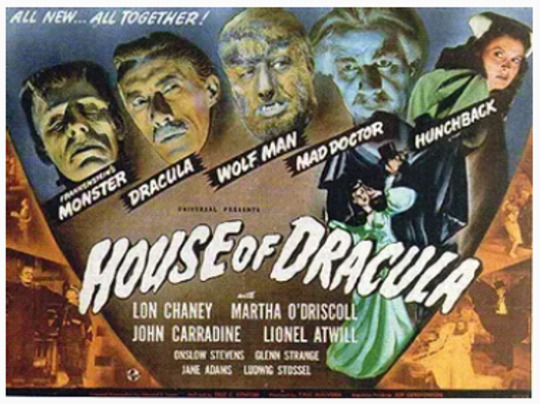
Svengoolie will be showing this movie tonight !
House of Dracula a Universal Horror film from the year 1945.
After the events of House of Frankenstein, the yet again revived Wolf Man Larry Talbot is still seeking release from his condition. He ends up in Dr. Edelmann's place for treatment and accidentally finds Frankenstein's Monster in the caves under the house. Count Dracula is also there to find a cure for vampirism, but it is only a ruse to get near the nurse Morelle, upon whom he has set his sights.
This film is also notable for having a female hunchback assistant, though she is treated as a sympathetic and kind character (and is quite pretty to boot).
The film was the last serious Monster Mash film for Universal. Next up, the comedy duo Abbott and Costello would stumble upon the horrors of the studio.
The film was developed initially with the title Wolf Man vs. Dracula to be directed by Ford Beebe with Bela Lugosi reprising his role of Count Dracula. After actor Boris Karloff returned for a two-film deal with Universal and several requests from the censorship board, the film was put on hold for nearly six months. House of Dracula went into production directed by Kenton with a screenplay by Edward T. Lowe, who took elements from the Wolf Man vs. Dracula script while adding in Frankenstein's monster to the plot. Many cast and crew members returned from House of Frankenstein, including John Carradine in the role of Count Dracula, Glenn Strange as the monster, and Lon Chaney Jr. as both the Wolf Man and Larry Talbot. The film went into production on September 17, 1945, and finished on October 24. The film uses large sections of music from previous Universal feature films and footage, sets and props from other early Universal horror films. The film was released on December 7, 1945. Historian Gregory Mank described it as "the final serious entry of Universal's Frankenstein saga". It received predominantly negative reviews in its early New York screenings, while retrospective reviews have been predominantly lukewarm.
#House Of Dracula#Svengoolie#1945#Dracula#Count Dracula#Vampire#Frankenstein#Werewolf#Universal#Wolf Man#monsters#Halloween#Horror#MeTV
3 notes
·
View notes
Text
Us, May 3
You can buy a brand new copy of this issue without the mailing label for your very own at my eBay store: https://www.ebay.com/str/bradentonbooks
Cover: Pregnant Meghan Markle: My Baby, My Way

Page 2: Red Carpet -- rufflemania -- Hollywood style stars are tier-ing it up in this flattering design with feminine flair -- Tracee Ellis Ross, Kaitlyn Dever, Margot Robbie, Logan Browning, Nicola Coughlan
Page 3: Lizzo, Maude Apatow, Lucy Boynton, Jessica Alba, Lily Collins
Page 4: Who Wore It Best? Anya Taylor-Joy vs. Isla Fisher vs. Regina King in Stuart Weitzman Nudist sandal
Page 6: Loose Talk -- Shonda Rhimes on the intense backlash she received over Rege-Jean Page's exit from Bridgerton, Kelly Ripa on her most embarrassing interview, Luke Bryan on his mother LeClaire's Instagram fame, Blake Shelton on The Voice's new coach Ariana Grande, Reese Witherspoon joking about wearing bottoms that aren't sweatpants
Page 8: Contents

Page 10: A Final Farewell to Prince Philip, his four children Prince Charles and Princess Anne and Prince Andrew and Prince Edward were among the loved ones who participated in the emotional ceremony, feuding brothers Prince Harry and Prince William (and his wife Duchess Kate) put their differences aside after the intimate service, due to Covid-19 protocols the grieving Queen Elizabeth stayed socially distant from the other 29 people who attended the funeral for her husband of 73 years
Page 11: ACM Awards 2021 -- Maren Morris teamed up with her husband Ryan Hurd and won Female Artist of the Year, Thomas Rhett won Male Artist of the Year, Carrie Underwood took the stage
Page 12: Hot Pics -- Rosie Huntington-Whiteley wore an orange coat during a visit to NYC, John Stamos plays a coach on the TV show Big Shot, Zach Braff goofed around on the set of Cheaper by the Dozen in L.A.
Page 13: Eva Longoria on her trampoline while aboard a yacht in Miami, Howie Mandel arrived to the set of America's Got Talent dressed as a bug in Pasadena
Page 14: Jon Hamm and his rescue dog Splash strolled around the neighborhood in L.A., Heidi Klum in all white in Pasadena, Sara Gilbert and Linda Perry take a stroll in L.A.
Page 15: Eddie Cibrian and LeAnn Rimes held hands after dinner at Il Segreto in L.A., Patrick Dempsey shot a scene for his show Devils in Rome
Page 16: Rachel Brosnahan in a blue dress and carrying a clear umbrella on the set of The Marvelous Mrs. Maisel in NYC, Lin-Manuel Miranda at the opening of a vaccination center for Broadway workers in Times Square, Trisha Yearwood feeds one of her rescue pups
Page 18: Gen Z Has Spoken -- these celebs are making the young kids proud -- Baggy Jeans -- Hailey Bieber, Tracee Ellis Ross, Bella Hadid
Page 19: Middle Parts -- Busy Philipps, Lizzo, Jennifer Lopez, Kourtney Kardashian, baguette bags -- Dua Lipa, Elsa Hosk, Irina Shayk, Kendall Jenner
Page 20: Seeing Double -- stars bear a striking resemblance to their famous counterparts -- Elizabeth Banks and Chelsea Handler, Emmanuelle Chriqui and Nina Dobrev, Betty Gilpin and Jodie Comer
Page 21: Rob Lowe and Ian Somerhalder, Jaime Pressly and Margot Robbie, Isla Fisher and Amy Adams, Rupert Grint and Ed Sheeran, Kyle Richards and Kacey Musgraves
Page 22: Clueless Crew -- stars are totally buggin' over Cher Horowitz's style in yellow plaid -- Robin Roberts on Good Morning America, Katie Holmes was rollin' with her homie beau Emilio Vitolo Jr. in NYC, Vanessa Hudgens, Dianna Agron
Page 23: Gabrielle Union
Page 24: Stars They're Not Like Us -- Jay Leno took one of his vintage automobiles out for a spin in L.A., Chrissy Teigen and John Legend took a selfie with a fan while grocery shopping in Beverly Hills, Kylie Jenner has custom vending machines
Page 25: Carrie Underwood in her massive walk-in closet, Denzel Washington signs autographs for fans in NYC, Megan Thee Stallion on a private plane, Drake and his bodyguard in Beverly Hills
Page 26: Stars They're Just Like Us -- Sarah Jessica Parker catches a yellow cab after working at her shoe store in NYC, Brad Paisley picked up five pizzas to go in Montecito
Page 27: Kelly Osbourne handed out goods at a drive-thru food distribution event at the Islamic Center of Southern California, HGTV's Egypt Sherrod transformed her closet into a meditation space in Atlanta, in between filming Law & Order: SVU's Mariska Hargitay and Ice-T take a selfie
Page 28: Hollywood Dads -- Scott Porter on parenting his two kids McCoy and Clover
Page 29: Jonathan Tucker on life with twins Hayes and India, parenthood is a lot tougher than Jovi Dufren imagined, Maksim Chmerkovskiy can't wait to show son Shai his work
Page 30: Love Lives -- Rihanna and A$AP Rocky are showing no signs of slowing down -- the pair enjoyed a night out in L.A. hotspot Delilah where they were holding hands and laughing and they're not hiding the fact that they're dating but they just don't want people in their business -- they're a good match and are each other's best friend
Page 31: Justin Bieber and Hailey Bieber may look like the picture-perfect couple, but Justin admits that their first year of marriage wasn't what he expected, saying it was really tough and there was just a lack of trust and he blamed the strain on his own personal struggles and said before he didn't have someone to love or someone to pour into but now, more than two years after exchanging vows with Hailey, he has that
* Kacey Musgraves' romance with Dr. Gerald Onuoha is giving her butterflies -- the pair are so happy they found each other and while Kacey, who split from her husband Ruston Kelly last summer, is trying not to get too ahead of herself, her connection to the Nashville-based doc is off the charts and it's got the potential to go a very long way
* Today's Savannah Guthrie is thankful to have husband Michael Feldman in her life, especially given the demands of her early morning work schedule
Page 32: Kourtney Kardashian and Travis Barker are getting serious -- all the details on their whirlwind romance
Page 33: Adapting to parenthood has been a breeze for Emma Stone and she's soaking in all the precious moments of being a mom for the first time -- she and husband Dave McCary welcomed their baby daughter in March and Emma is super protective and a very hands-on mom and Dave is also hands-on and helps with their daughter -- thanks to the little one, Emma's marriage with the comedian has also gotten stronger and having a baby has brought them closer in a way they never expected -- Emma is looking forward to getting back to work; she's taken this time off to embrace motherhood and her number one priority is to raise a healthy baby so that's what she's focused on right now

* Britney Spears is setting the record straight -- despite her ongoing conservatorship battle with her dad, Jamie Spears, she is doing totally fine, assuring fans that she's extremely happy and she has a beautiful home, beautiful children and she's taking a break right now because she's enjoying herself -- although the legal drama with her father is heating up, Britney is staying strong and she has this wonderful ability to see the positive even when the odds are against her
* Keeping Up With Us -- production for the Downton Abbey sequel is underway, Mossimo Giannulli is a free man, Chrissy Teigen returned to Twitter 23 days after announcing that she was leaving the platform, Vanessa Bryant remembered her late husband Kobe Bryant on what would have been their 20th wedding anniversary, Helen McCrory lost her battle with cancer at age 52 according to her husband Damian Lewis
Page 34: A Day in My Life -- Whitney Port
Page 35: Colton Underwood is ready to live his truth -- during an interview on Good Morning America, the former Bachelor came out as gay, saying he's run from himself for a long time and he came to terms with his sexuality earlier this year and he's the happiest and healthiest he's ever been -- now that he feels like he can finally breathe, Colton is excited for his next chapter, which fans will get to see on an upcoming reality show with Olympian Gus Kenworthy -- a huge weight has been lifted off of Colton's shoulders and he is looking forward to being his authentic self
Page 36: Moms Tell All -- Happy Mother's Day! From milestones and manners to rules and nanny-bans, celebs and insiders talk about raising kids in Hollywood
Page 37: Bindi Irwin says life at home with her daughter Grace Warrior has been positively blissful and her family with dad Chandler Powell is so full of love, adding that the newborn has already met some of the wildlife at the Australia Zoo where Bindi and Chandler live and work and of course she's seen some crocs and really lit up when she saw them -- while the Aussie conservationist is sad Grace won't get to meet her late dad Steve Irwin, Bindi's brother Robert Irwin and mom Terri Irwin have been by her side constantly and Robert is obsessed with Grace and has been helping out so much and her mom has been the biggest guiding light and she's already taught Bindi so much about being a mother, both in how she raised her and by showing her things day by day and Terri is quite the baby whisperer and she's so great a calming Grace down when she's crying -- first-time father Chandler is also a natural with Grace and he's been the most supportive and involved dad and together, he and Bindi make such a great team -- for now, Bindi, who stars with Chandler in Crikey! It's a Baby!, is hoping Grace will follow in her animal-activist footsteps, saying having three generations of strong women working as conservationists is a dream come true
* Jennifer Garner said teaching your kids is a lifelong job, and certainly values are something you have to show them -- Jennifer, who shares kids Violet, Seraphina and Samuel with ex Ben Affleck, is staying true to her word and has led by example when it comes to things like kindness and patience and she won't let anyone in the house to judge or speak ill of people, and she enforces the same wholesome, traditional values that she was raised with and the kids have been taught to be loving, hardworking and fair -- Jennifer has always taken a kids-come-first approach to parenting, and it shows as they bake together, enjoy movie nights, read books and have very active lives and it's a very healthy, happy household filled with laughter and love
Page 38: Gwen Stefani has her hands full with her sons Kingston, Zuma and Apollo with ex-husband Gavin Rossdale, but she wouldn't want it any other way -- Gwen's a tomboy, so having three boys wasn't daunting for her at all, plus she has fiance Blake Shelton by her side to pitch in with parenting duties and Gwen and the boys have a blast at Blake's ranch in Oklahoma where they enjoy riding their ATVs, and they play baseball and football -- it's not all fun and games, though because Gwen is big on boundaries and manners and she doesn't want to raise Hollywood brats and it's important to her that her sons be gentlemen
* Meghan Markle's pregnancy with Archie was no walk in the park, as she revealed during her bombshell TV interview with husband Prince Harry, the couple had concerns over whether or not the royal family would provide security for their son and claimed there were conversations about his skin color -- but this time around, as Meghan and Harry gear up for baby No. 2 at home in L.A., she's doing everything her way, without the royals and Meghan and Harry feel blessed that they're able to raise their daughter in the U.S. and can live by their own rules and make the decisions they feel are best for their children; having independence is the most important thing for Meghan and she's got free rein to be exactly the kind of mom she wants to be -- her parenting style is really like most mothers out there, and she's been craving pasta and doing yoga two times a day as her due date nears and she keeps a lot of art supplies out to foster creativity and healthy snacks around and she's a devoted mom and wants the best for her kids
Page 39: Kate Hudson has a lot on her plate, so the mom of three, who shares son Ryder with former husband Chris Robinson and son Bingham with ex Matt Bellamy and daughter Rani with boyfriend Danny Fujikawa, knows when to put her foot down as things can get a little overwhelming at times for Kate, but when she says no, it absolutely means no, and the kids respect her very much because of that
* Gigi Hadid, who shares daughter Khai with boyfriend Zayn Malik, wants to spend every waking moment with her precious little girl -- Gigi could easily afford to employ a team of nannies but chooses not to and she prefers to do everything herself and besides, she can't bear to be away from Khai for more than a few hours
* Candace Cameron Bure's three grown kids are flying the coop, but she's still super involved in their lives, despite slowly becoming an empty nester -- the mom of Natasha, Lev, and Maksim with former hockey player Valeri Bure says it's been a very transitional time and she's been trying to help them make decisions they feel good about and it's challenging, but they're figuring it out
Page 40: Oh, Baby! Meghan Markle's due date is just around the corner, and here are all the details
* Bump Brigade -- Halsey, Gal Gadot, Shawn Johnson East
Page 42: 10 Years of the Cambridges -- a look back at Prince William and Duchess Kate Middleton's solid marriage for their anniversary
Page 44: Jennifer Lopez and Alex Rodriguez: What Really Happened -- cheating and lies? The truth behind J.Lo's split from fiance A-Rod
Page 45: Friendliest Exes -- these former couples managed to stay close after going their separate ways -- Gwyneth Paltrow and Chris Martin, Jennifer Aniston and Justin Theroux, Orlando Bloom and Miranda Kerr, Demi Moore and Bruce Willis, Lisa Bonet and Lenny Kravitz
Page 48: Gifts for Mother's Day
Page 54: Entertainment -- Ben Barnes on Shadow and Bone
Page 58: Fashion Police -- the most daring Oscars looks -- Bjork, Whoopi Goldberg, Charlize Theron
Page 59: Rachel Weisz, Gwyneth Paltrow, Lady Gaga
Page 60: 25 Things You Don't Know About Me -- Julia Michaels
#tabloid#grain of salt#tabloid toc#tabloidtoc#bindi irwin#chandler powell#grace warrior irwin powell#jennifer garner#gwen stefani#meghan markle#prince harry#kate hudson#gigi hadid#candace cameron bure#the cambridges#prince william#duchess kate#kate middleton#catherine duchess of cambridge#jennifer lopez#alex rodriguez#ben barnes#shadow and bone#general kirigan#fashion police#julia michaels#colton underwood#whitney port#britney spears#emma stone
20 notes
·
View notes
Text
FLIGHTLINE: 201 - US ARMY VTOL EXPERIMENTS # 3 - OTHER AVENUES
The US Army, despite limitations established after the USAF was established, continued to experiment with VTOL aircraft into the 1960s
BACKGROUND Recognizing the potential of winged heavier-than-air flying machines first demonstrated by the Wright Brothers in 1903, the US Army Signal Corps established the Aeronautical Division, Signal Corps on 1 August 1907 to train pilots, and develop and operate aircraft. Operations expanded and the name changed several times between then and 1941, when the US Army Air Corps was renamed the US Army Air Forces just prior to America's entry into WWII. During the post-war reorganization of the military and intelligence agencies formally adopted under the National Security Act of 1947, the USAAF was established as a separate branch under the National Military Establishment (renamed the Defense Department in 1949). Further refined by the 1948 Key West Agreement and the 1952 Pace-Finletter Memorandum of Understanding (MOU), the USAF was established as the primary operator of fixed wing aircraft for both offensive (fighter, bomber, attack), defensive (interceptor, long range recon) and support/transport duties, while the US Army's fixed wing fleet was limited to theater-level transport and utility, observation/spotting, command and control of Army forces, and medivac. Additionally, the Army was freed from weight restrictions and was allowed to develop helicopters for attack, transport and other roles. Seeking ways to develop more capable fixed-wing craft within those restrictions (or to side-step them entirely...), the Army began looking into various vertical takeoff and landing (VTOL) technologies in the 1950s, requesting proposals for one-man platforms, flying jeeps, and larger aircraft that could be adapted for recon, transport or perhaps even attack missions.
VERTOL VZ-2 On 15 April 1956 the Army and Navy signed a joint contract with Vertol (formerly Piasecki) to build a demonstrator to test tilltwing technology, that is, an aircraft built to allow the wing and engines to be tilted such that the thrust is pointing downwards, allowing the aircraft to take off vertically, then tilt the wing back down for forwards flight. The resulting Model 76 was a skeletal framework of aluminum tubing with a bubble cockpit at the front (both the frame and cockpit were adapted and built from components for the Bell Model 47 to reduce costs) with the high-mounted wing at mid point and a t-tail at the rear. A fixed taildragger landing gear was fitted, while a small wheel under the cockpit was also provided in case of difficulties. The Model 76 was 26' 5" long and 15' tall, with a wingspan of 24' 11". The three-bladed, variable-pitch props, each 9' 6" in diameter, were powered by a single Lycoming T53-L-1 turboshaft, rated at 700shp, which was mounted within the fuselage. A complex series of shafts and linkages connected the engine with the main rotors/propellers, as well as to a pair of smaller ducted fans, one each in the horizontal and vertical stabilizer, which were used to control yaw and pitch while in hover. The rotors, which were interconnected for safety, were also used to adjust pitch in hover, while more traditional aircraft flight surfaces would take over once in horizontal flight. Empty, the VZ-2 weighed 2,500lbs, while max weight was 3,700lbs.

-Line drawing of the Model 76. | Illustration: Boeing Vertol
Vertol delivered the aircraft, designated VZ-2 by the Army, in 1957, with ground testing beginning in April, followed by the first hover flight on 13 April. On 15 July 1958 the VZ-2 completed its first full flight, starting with a vertical takeoff, transitioning to wing-borne flight, then returning to hover mode for a vertical landing. The aircraft proved to be fairly agile, but was slow even in horizontal mode, setting a maximum speed of 210mph and a ceiling of 13,800 feet. Range, not particularly a concern of a research aircraft, was only 130 miles. In addition to the Army and Navy, the VZ-2 was flown by NASA for a time. The craft was retired in 1965, completing 450 flights, which included 34 full transitions. The VZ-2 is currently in storage at the Paul E. Garber Preservation, Restoration, and Storage Facility of the National Air and Space Museum.

-The VZ-2, resplendent in white and day-glo orange scheme. | Photo: NASA
RYAN VZ-3 VERTIPLANE The Ryan Model 92 Vertiplane, designated the VZ-3RY by the Army, was designed to test the principle of deflected slipstream to enable a fixed-wing aircraft to achieve VSTOL without the complexity of a tilted wing or engine design. Originally built with a tailwheel design, the aircraft was rebuilt after a non-fatal accident in a slightly lengthened form with a tricycle arrangement. The high-mounted wing was fitted with full-width double-slotted flaps and down-turned wingtips that acted to contain and direct the airflow down, allowing the Vertiplane to take off after a 30-foot ground roll at a speed of just 25mph. Power was provided by an Avco Lycoming T53 turboshaft, mounted in the fuselage and shaft-linked to the two nine-foot diameter, three-bladed props. To provide control in a hover, the jet exhaust was fitted with a deflection nozzle. The aircraft could achieve a hover at altitudes up to 3,700 feet, but during testing it was discovered that a low-altitude hover would reingest air from its own slipstream (which possibly caused the crash). Construction of the Vertiplane began in 1957, with maiden flight taking place on 29 December 1958 and the Army completing 21 test flights before the VZ-3 crashed in 1959. Along with the rearranged landing gear, the rebuilt VZ-3 was also fitted with an open cockpit, bringing plane in its final configuration to 27 feet 8 inches long with a wingspan off 23 feet and a height of 10 feet 8 inches. After the rebuild the Vertiplane was handed over to NASA for further testing, and it was officially retired in 1961. In 2018, after a lengthy restoration, the VZ-3 was placed on display at the US Army Aviation Museum.
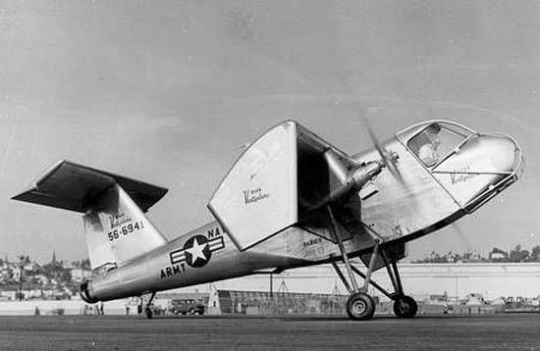
-The Vertiplane as originally completed. | Photo: US Army
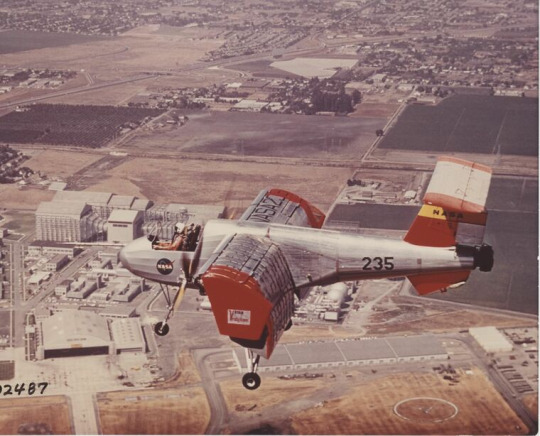
-The rebuilt VZ-3 during NASA testing. The span and length of the flaps at full extension is apparent in this view. | Photo: San Diego Air and Space Museum Archives

-The Vertiplane in the Army Aviation Museum. | Photo: US Army
DOAK VZ-4 Edmund R. Doak, Jr. was a self-taught aviation engineer and former VP of Douglas Aircraft who in 1940 formed Doak Aircraft. The company served as a subcontractor during WWII, eventually employing 4,000 workers. After the end of the war, Doak proposed a VTOL aircraft to the Army that would have the speed, range and firepower of a fixed-wing aircraft and the ability to take off vertically, hover and land vertically like a helicopter (which would also allow the Army to skirt the restrictions against operating fixed wing attack aircraft). On 10 April 1956 the Army awarded Doak a contract to build a single prototype of their Model 16 for use as a research aircraft. Designated the VZ-4DA and built with serial number 56,9642, the Model 16 was constructed from welded steel tube covered with fiberglass from the cockpit forward and with aluminum sheet over the remainder of the fuselage, which was 32 feet long. The mid-mounted wings were of all-metal construction and had two 5 foot diameter ducted fans on either wingtip, bringing the span to 25 feet 6 inches total. The fans could be moved through 92°, allowing the VZ-4 to take off vertically, fly horizontally, and hover (the fans pointed two degrees aft of vertical in hover to counteract the exhaust of the jet). Initially powered by a single Avco Lycoming YT53 turboshaft of 840shp, a more powerful T53-L-1 of 1,000shp was later substituted. As with the VZ-3, diverter vanes allowed the pilot to direct the thrust of the jet engine to control pitch and yaw in hover. In order to speed construction and cut costs, the VZ-4 utilized components from other aircraft, including the landing gear from a Cessna 182, the seats from a P-51 Mustang, and actuators from a T-33 Shooting Star. Despite being an R&D aircraft, the VZ-4 sat two, a pilot and observer, in tandem seats. The flight controls consisted of a standard stick and rudder, with mechanical linkages and interlocks adjusting the ducts, vanes, tabs and flaps as the aircraft went through all phases of flight. There was no artificial stabilization or power boost system.

-Orthograph of the VZ-4. | Illustration: Doak Aircraft Company
Doak began ground tests in February 1958, with the Model 16 completing 32 hours of stand testing and 18 of tethered testing before the first free flight on 25 February 1958, then the first full transition flight on 5 May. Following a complete tear-down inspection of the craft, it was shipped to Edwards AFB in October for 50 hours of further acceptance testing. The Army accepted the VZ-4 in September 1959, after which it was transferred to NASA Langley to begin test work on its VSTOL performance.
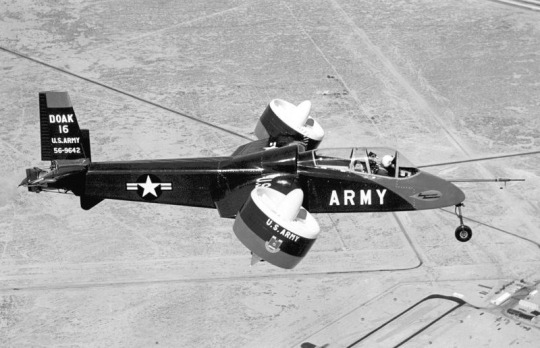
-The VZ-4 over Edwards in 1958. | Photo: US Army
The VZ-4 performed adequately during the Army and NASA tests; demonstrating the ability to hover and shift between horizontal and vertical flight at altitudes of up to 6,000 feet, A maximum speed of 230mph, a cruise speed of 175mph, a range of 250 miles with an an endurance of one hour, and a service ceiling of 12,000 feet. A few vices did crop up, the most serious of which was a tendency to nose-up when going from vertical to forward flight; additionally, STOL performance was less than anticipated. Doak's engineers were confident that they could correct these issues, with a swap to a more powerful T53 turbine being the first step. Before additional measures could be taken however, Doak, hit by financial problems due to a general recession in 1960, laid off 90% of their staff. The VZ-4 program was subsequently purchased by Douglas Aircraft, but by this point the Army had lost interest in the idea as improvements in aerodynamics and engines had produced helicopters which met their needs. The aircraft was transferred to NASA in 1963 and was flown sparingly until 1972, when it was grounded permanently. The VZ-4 was placed into storage at Fort Eustis in 1973 before being donated to the US Army Transportation Museum, where it is now on display.

-The VZ-4 on display at the Army Transportation Museum. | Photo: Vladimir Yakubov
FAIRCHILD VZ-5 FLEDGLING Like the Ryan Vertiplane, the Fairchild VZ-5FA was designed to test the principle of deflected slipstream to enable VSTOL flight. Known as the Model M-244-1 by Fairchild, the aircraft was of simple construction, with an open cockpit fuselage nearly thirty-four feet long mated to a high-mounted wing nearly thirty-three feet in span. A GE YT58 turboshaft of 1,032shp drove four small four-bladed props as well as two even smaller props in the tail for pitch and yaw control. In addition to conventional flaps and ailerons for control in normal flight, nearly two thirds of the wing would act as a full-span flap for VTOL flight. Extensive wind tunnel testing at NASA Langley cast doubt on the airworthiness of the Fledgling's design, with the aircraft producing almost enough lift to carry its empty weight aloft, but no fuel, pilot or cargo. The VZ-5 was also determined to be unstable in every flight regime, with violent pitching encountered and the available flying surfaces unable to compensate. Despite this bleak report, Fairchild pressed on and tethered tests began on 18 November 1959. The exact number of tests of the Fledgling are not known but suspected be in the low single digits, and the series only reinforced the conclusions drawn from the wind tunnel testing. The VZ-5 was abandoned before the end of 1959 and was apparently quietly scrapped.

-The VZ-5 from in front and behind. The Fledgling likely never actually took flight, a victim of poor aerodynamics. | Photo: US Army
LOCKHEED VZ-10 HUMMINGBIRD In 1959 the Army awarded a contract to Lockheed for two examples of the VZ-10, an experimental STOVL observation aircraft based on Theodore von Karman's "augmented jet ejector" concept. Under von Karman's concept, jet exhaust was passed through a specially shaped chamber which drew in ambient air from the outside, which in lab tests had proven to increase thrust by two times. Lockheed's design resembled a conventional aircraft 32 feet long with narrow-chord, mid-mounted wings giving it a wingspan of just 25 feet. The interior volume of the fuselage was taken up by two P&W JT12A-3LH turbojets, along with the thrust diverter system. Fed by doors at the top of the fuselage, doors at the bottom would allow exhaust to lift the aircraft, while they could also be closed and allow the aircraft to take off and fly conventionally. Diverted exhaust could also be used to maneuver the aircraft during hover, while conventional flying surfaces were used during normal flight.

-Orthograph of the VZ-10. | Illustration: airvectors.net
Prior to first flight, the aircraft was redesignated the XV-4, with the maiden flight (conventional) occurring on 7 July 1962. This was followed up by a hovering flight on 24 May 1963 and a transitional flight from hover to conventional on 8 November 1963. The thrust augmentation system proved to be heavier and less effective than anticipated, resulting in the Hummingbird having a thrust-to-weight ratio of on 1.04. Still, the XV-4A set a max speed of 518mph and a range of 600 miles. The first XV-4 crashed on 10 June 1964, killing the pilot and destroying the plane.
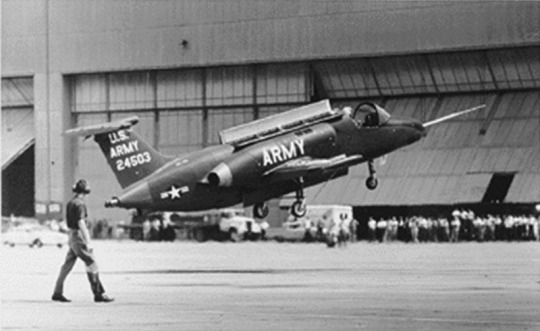
-The XV-4A Hummingbird during testing. | Photo: Lockheed/US Army
The second prototype was built to a different standard, designated the XV-4B. The two JT-12 engines and the diverter system were replaced by six GE J85 turbojets, four set vertically to act as lift jets and two set horizontally to provide forward thrust. The XV-4B was slightly larger than the A model, and much heavier, the A had an empty weight of just under 5,000lbs and a gross of 7,200lbs versus the B, which weighed 7,400lbs empty and almost 12,600lbs gross. The upgraded engines improved the thrust to weight ratio to 1.43, but the added weight reduced the top speed to 463mph. The XV-4B also had an improved stability system, giving the pilot a better feel for the controls and more authority in a hover. The aircraft was rolled out on 4 June 1968 and soon began a short builder's trial before being shipped to Edwards AFB for flight testing conducted by North American Rockwell on behalf of the USAF. The B model was lost in a crash on 14 March 1969, although the pilot was able to escape in the ejection seat. The Army canceled the program at this point, seeing no further development in the future.
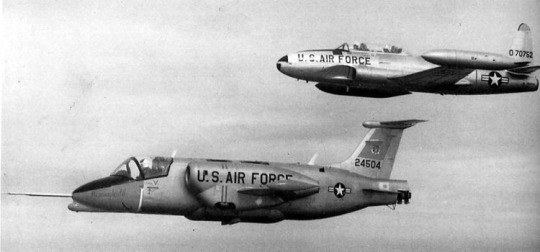
-The XV-4B, with a T-33 chase plane, at Edwards AFB. | Photo: USAF
RYAN VZ-11 VERTIFAN In 1959 Ryan Aeronautical, who had been working on the X-13 Vertijet, a jet plane that could VTOL onto a dedicated platform, for the USAF, proposed an aircraft operating on a different principal, ducted fans, to the US Army. The Army in turn awarded a contract for two VZ-11-RY Vertifans, redesignated the XV-5A in 1962.

-Orthograph of the XV-5. | Illustration: Aeroplane Monthly

-Labeled cut-away drawing of the Vertifan. | Illustration: Ryan Aeronautical
The Vertifans were 44 feet 6 inches long, with a wingspan of 29 feet 10 inches and a height of 14 feet 9 inches. Empty weight was just over 7,500lbs, while max takeoff weight was 13,600 conventionally and 12,300lbs while employing VTOL. Two General Electric J85s, rated at 2,600lbs each, propelled the aircraft forward, as well as driving the two GE X353-5 ducted fans in either wing, which measured 62.5 inches in diameter, as well as a smaller 36in fan in the nose. While operating in lift-fan mode, the engines produced 16,000lbs total thrust, three times that available from the turbojets alone. Cross-ducts provided a measure of safety, as either jet could dive the whole system in case of a failure. Louvered vanes underneath the fans provided yaw and roll control, while pitch control was effected via engine power settings. Traditional flying surfaces on the wing and T-tail provided control in conventional flight. The vanes underneath the fans as well as doors on top could be closed during normal flight to reduce drag. Additionally, the narrow-track landing gear was retractable. The wings of the XV-5 were vaguely based on the delta wing of the A-4 Skyhawk, and the intake duct for the engines was placed above and behind the two place cockpit.

-This photo, from the front and underneath the XV-5A, shows the narrow track of the landing gear. | Photo: Ryan Aeronautical
While the XV-5s were under construction the 15 pilots chosen, known as the "XV-5A Fan Club", were trained on a flight simulator provided by Ryan. The first Vertifan was rolled out in early 1964, with the maiden flight taking place on 25 May. Testing progressed, but uncovered numerous issues with the aircraft. The J85s produced too little thrust, giving the XV-5 poor acceleration during conventional takeoffs. During hovers, the control system provided too little yaw authority, and opening and closing the louvers and doors caused abrupt changes in pitch. There were also issues with the opening mechanisms, which proved to have poor reliability. The first Vertifan crashed during a public flight demonstration on 27 April 1965, killing Ryan test pilot Lou Everett. The post-crash investigation determined that the Everett had inadvertently tripped the conventional-to-vertical conversion switch, which was mounted on the collective. The switch automatically triggered the horizontal stabilizer to force the nose down almost 45°, a maneuver intended to compensate for the lift generated by the nose fan. Everett initiated his low-altitude ejection seat, but it malfunctioned and he was killed.
The second Vertifan was modified, with the conversion switch, now a lift-lock toggle, being moved to the instrument panel. Trials resumed, with an emphasis on turning the plane into a search-and-rescue vehicle. A winch and rescue sling was added, with the idea being that a downed airman could be retrieved and winched into a compartment behind the pilot. During a test of the system on 5 October 1966, the sling was ingested into one of the wing fans. The pilot, Major David H. Tittle, ejected, but too late, and died of internal injuries he sustained when the seat impacted the ground. The plane was salvaged and rebuilt into the XV-5B, which featured fixed landing gear which was more widely spaced, improved controls, and improved lift and thrust capability. The Army, having lost interest in VTOL research in general and the Vertifan in particular, abandoned the project. The XV-5B was turned over to NASA for further testing, and was delivered in the agency's paint scheme of overall white with blue trim.

-Composite photo of the XV-5B in flight and on the runway. | Photo: NASA
The XV-5B continued to be flow by NASA until 1971, providing much data on lift fan technology. General Electric took some of the lessons learned from the J85 engines and X353 fans and adapted them into the earliest high-bypass turbofan engines, the TF39, which powered the C-5A Galaxy. The Verifan was the last manned aircraft produced by Ryan, which pivoted into unmanned aircraft in the mid 1960s. The XV-5B, still in its white NASA paint scheme, was retired and placed on display at the US Army Aviation Museum at Ft Rucker.

-The XV-5B Vertifan, on display outside the US Army Aviation Museum. | Photo: Alan Wilson.
SUMMARY The Army ceased supporting VTOL research during the late 1960s. Budgets were stretched by the war in Vietnam, and development of more capable helicopters like the UH-1, AH-1 and CH-47, resulted in a diminished interest in alternative technologies.
#airplane#aircraft#airplanes#vtol#us army#naca#nasa#the fifties#the sixties#the 50s#the 60s#Cold War#coldwar#cold war history#ryan aircraft#lockheed#Fairchild republic#boeing vertol#Aviation#avgeek#vstol#stovl
3 notes
·
View notes
Text
The Silva Screen

Howard Da Silva
Am I the only one who constantly gets character actors Howard Da Silva and Henry Silva confused?
Howard Da Silva was born in Cleveland in 1909 and was working as a steelworker when he decided to go to drama school. He first appeared on Broadway at age 20, and made a name for himself playing Jud in the original production of Oklahoma!.
Da Silva (born Silvablatt) was a burly, jowly man with a boxer’s face, thinning hair and an unmistakable voice, half-midwest, half Lower East Side. He made the move to Hollywood in the mid-thirties and, over the next decade and a half established himself as a familiar screen presence playing gruff but ultimately understanding characters. He was the tough but fatherly criminal mentor in They Drive By Night, and Nat, Ray Milland’s wise but increasingly frustrated bartender in The Lost Weekend. He played opposite Alan Ladd and Veronica Lake in The Blue Dahlia, Edward G. Robinson and John Garfield in The Sea Wolf, and portrayed Wilson in the 1949 adaptation of The Great Gatsby.
After actor and fink Robert Taylor, while testifying as a friendly witness before HUAC in 1947, described Da Silva as a troublemaker “who always has something to say at the wrong time,” Da Silva himself was called to testify about his supposed communist sympathies. When brought before the committee in 1951, Da Silva became the first of over three hundred writers, actors and directors to refuse to answer questions, citing the Fifth Amendment. He was promptly blacklisted and for much of the next decade vanished from movie and television screens, though he continued to work in theater.
When he reappeared in the early Sixties, older, balder, and jowlier, he found himself playing an array of historical figures from Ben Franklin to Franklin Roosevelt to Boss Tweed to, ironically, Nikita Kruschev in The Missiles of October and Louis B. Mayer in Mommy Dearest. He also appeared in the 1974 adaptation of The Great Gatsby, this time around playing Meyer Wolfsheim. He made his final screen appearance in 1984’s Garbo Talks, and died of cancer two years later.
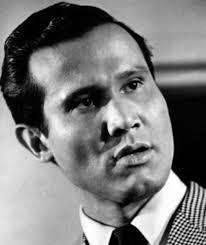
Henry Silva
Henry Silva, meanwhile, was born in Brooklyn in 1928. Although often accused of being Puerto Rican, he insisted his mother was Spanish and his father Sicilian. His father walked out on the family when Henry was three months old, at which point he and his mother moved to Harlem.
Silva, who had decided early on to become an actor, dropped out of public school at age 13 and enrolled in acting classes, taking a dishwashing job in a local hotel restaurant to help support him and his mother. Fourteen years later, he’d finally worked his way up the ranks to become a waiter in that same hotel.
Then twenty-seven, Silva, having grown into a darkly handsome young man standing six-foot-two, decided to apply to the Actor’s Studio, and was accepted. He soon made his Broadway debut in in 1956 in A Hatful of Rain, with classmates Shelley Winters and Ben Gazzara. The play became such a hit it soon landed Silva in Hollywood, where he co-starred in the 1957 film adaptation.
His commanding stature and sharp, angular, swarthy good looks not only made Silva an easy choice for producers looking for a suave but sinister villain, they also allowed him to play everything from Mexicans to Russians to Italians to Middle Easterners to Asians to Native Americans with very little extra makeup. He was a chameleon without even trying.
In the Fifties and early Sixties he played a string of suave and sinister gangsters, killers and thieves on TV series like The Untouchables, Climax and The Outer Limits and in films ranging from Green Mansions to Ride a Crooked Trail. He became a regular Rat Pack satellite, appearing in Ocean’s 11, Sergeants 3, and making guest spots on The Joey Bishop Show, as well as playing one of the evil stepbrothers in Jerry Lewis’ Cinderfella. In what may have been his breakthrough role, he again co-starred with Sinatra in 1962’s The Manchurian Candidate as the double-crossing Korean guide who delivers Sinatra’s company into the hands of those dirty commies.
He earned his first starring role the next year as the titular Mob assassin Johnny Cool (co-starring fellow Rat Pack alumni Joey Bishop and Sammy Davis Jr.), after which he accepted an invitation from an Italian producer and moved his family to Rome. Over the next decade he would become a star throughout Europe, appearing in dozens of Spaghetti Westerns, occasionally even playing the hero.
He returned to the States in the mid-Seventies to once again co-star with Sinatra in 1977’s Contract on Cherry Street. Following that, he would spend much of the Eighties playing cartoon villains in comic strip movies (Buck Rogers, Dick Tracy) and and endless string of cheap jingoistic action films (Megaforce, Code of Silence), as well as a few sub-lowbrow comedies (Cannonball Run II, Lust in the Dust). He was admittedly spectacular in his brief turn as Brock, the would-be Great White hunter out to kill a monstrous alligator roaming the Chicago sewer system in Lewis Teague’s 1980 darkly comic monster movie Alligator.
After co-starring in Jim Jarmusch’s 1999 Ghost Dog: The Way of the Samurai and a quick cameo in the 2001 remake of Ocean’s 11, Silva retired from acting at age 73.
But back to where all this started—namely, am I the only one who gets Howard Da Silva and Henry Silva confused?
Yes, Howard Da Silva was some twenty years older than Henry Silva. And yes, Howard was born in Cleveland to Jewish parents while Henry was a Spanish-Italian kid from Brooklyn. And yes, Howard was a steel woorker while Henry washed dishes in a hotel restaurant. And yes, Henry was some four inches taller than Howard, and had thick black hair to boot. Yes, Henry tended to play suave and sinister villains while Howard tended to play gruff but lovable types. Yes, Henry played everything from Italians to Mexicans to Asians while Howard was as decidedly American as they come, and yes, Henry is still alive while Howard died in 1986. But if you’re going to say “Yes, you dunce, you’re the only one who gets them confused, because you’re stupid,” consider the following.
First, Henry Silva’s official biography is suspiciously inconsistent. Despite repeated claims about his heritage, a 1930 U.S. Census entry states that both of Silva’s parents were from Puerto Rico. But I guess being half Spanish and half Sicillian is much more Romantic than being just another Puerto Rican kid from Brooklyn. That same form also lists Henry’s given name as “Harry.” What’s more, after supposedly working at the same hotel for fourteen years, shouldn’t he have worked his way up to something more than waiter? You’d think he’d at least be night manager or something, right? And despite his claims he made his film debut only after the 1956 Broadway premiere of A Hatful of Rain, his first screen appearance was actually in 1952’s Viva Zapata!.
Now, given we can clearly not trust a thing Henry Silva says, or has ever said, about himself, ask yourself the following questions:
Is it mere coincidence that Howard Da Silva and Henry Silva, as prolific as both were, never appeared onscreen together? Their careers overlapped for some thirty years! What are the odds of that? I mean, Sinatra co-starred with Groucho Marx, for godsakes!
And is it sheer coincidence that Henry Silva’s film debut in Viva Zapata! occurred at the precise moment Howard Da Silva had been blacklisted? Think about it—Howard vanishes and Henry steps in. Hmm, right? Plenty of other blacklisted artists worked under the radar by using pseudonyms. Maybe Howard, given his troublemaking reputation, decided to take the idea of thumbing his nose at HUAC a few steps further. I mean, take a look at the two of them side by side. Give Howard some lifts, a little swarthy makeup and a black toupee and BOOM! He’s Henry Silva.
And what better way to throw off the scent than to play a completely opposite character type from the one you were known for? And how better to flip the bird, just for fun, than by playing a bunch of evil communists and revolutionaries?
After the blacklist ended, Howard was faced with a dilemma. He could work again, which was great, but what to do about Henry? Kill him off? Retire him? His career had just taken off and was going great guns in the early Sixties. Then it struck him—with Henry still around, he had two solid income streams flowing. Why give that up? Both Howard and his alter-ego Henry were character actors, after all, meaning they were rarely needed on set for more than a couple days on each picture. Easy as pie to do a Howard role one day, then a Henry role at the end of the week.
My god, it’s all so perfect! What an ingenious scheme! And what better way to throw everyone off the scent for good than to have Howard “die” in 1986? At that point, after all, Henry was awfully busy with those stupid action movies that paid so well, while Howard’s own jobs were becoming more sporadic and low-profile.
So there you have it, and remember you read it here first—Howard Da Silva and Henry Silva WERE THE SAME PERSON! I likely never would have figured it out for myself had Howard just put another minute’s worth of work into choosing a name for his alter ego back in 1952.
By Jim Knipfel
3 notes
·
View notes
Photo

It Happened on Fifth Avenue (1947)
When Frank Capra and Samuel J. Briskin founded the independent studio Liberty Films in 1945, It Happened on Fifth Avenue was slated to be the studio’s first motion picture. The story had the Capra hallmarks: a wholesome tale that rewards its characters’ selflessness, yet acknowledging the hardships and frustrations of American life. But Capra found other source material more interesting. He sold the rights to It Happened on Fifth Avenue to his friend, director Roy Del Ruth, and began work on some little movie called It’s a Wonderful Life instead. What became of It Happened on Fifth Avenue? It resulted in a moderate hit for Allied Artists, a newly-formed subsidiary of Monogram Pictures (a Poverty Row studio which was attempting to rid itself of its reputation of making low-budget movies that typically played in rural American theaters, rarely appearing in the nation’s urban centers).
Though it might not be as iconic as It’s a Wonderful Life or fellow 1947 film Miracle on 34th Street, it embraces the charity and altruism associated with Yuletide – fully realizing how difficult it can be for one to embody those characteristics.
A homeless man named Aloysius T. McKeever (Victor Moore) bring himself and his dog to the New York City mansion of Michael J. O’Connor (Charles Ruggles; whose character deals in real estate and is the nation’s second-richest person) every winter. Aloysius is not here to panhandle at the front door, but to enter through the broken back fence and squat in the mansion while O’Connor is reliably away at his Virginia estate from November 3 to March 13. This year is unlike any other year for Aloysius, though. He will invite newly-evicted veteran Jim Bullock (Don DeFore) and eighteen-year-old Trudy “Smith” (Gale Storm; whose character is actually O’Connor’s runaway daughter). And then, to Aloysius’ initial exasperation, Jim will invite his fellow veteran friends Whitey (Alan Hale, Jr.), Hank (Edward Ryan), and their families to reside in the mansion until they can find places for themselves. The fun for the audience begins when Trudy starts falling for Jim, and when Michael J. O’Connor himself returns earlier than scheduled.
A few character actors play those small character parts. Edward Brophy and Arthur Hohl play two patrolmen hired by O’Connor to keep watch of his mansion. Dorothea Kent is Whitey’s wife, Margie – and this time, Kent is not playing her typical dumb blonde charcters.
The years during and after World War II saw a significant housing shortage in the United States’ largest metropolitan areas – most visibly New York City, Los Angeles, and especially Washington, D.C. (see: 1943’s The More the Merrier). Americans flocked to the industrial and military-adjacent jobs that were located in these places. These hubs of materiel production could not construct housing fast enough to accommodate the demand – a situation worsened when WWII servicemembers returned from their overseas postings. Jobs may have been plentiful during wartime, but the housing shortage gripping the nation’s urban centers was widespread enough for Hollywood to make several films about or circuitous to the subject. This facet of history might be lost to younger viewers, as the housing crunch of WWII and the immediate post-War years are fading from living memory. But this development informs the attitudes found in It Happened on Fifth Avenue, implied and otherwise.
In the 1940s and even today, moviegoers infrequently experience a film headlined by character actors. It Happened on Fifth Avenue’s two central characters are among the finest in Victor Moore and Charles Ruggles. Moore and Ruggles play diametrically opposed characters. The former’s chronic homelessness has nothing to do with his humility and gentle humor; the latter’s uptight, business-first mindset will recall Dickensian misanthropes and misers transported to mid-twentieth century America. Their performances are splendid, even as Moore’s Aloysius begins to cede the spotlight to the younger actors and Ruggles by the film’s midpoint.
Moore represents the film’s moral conscience. He moralizes without lecturing; he teaches human decency incidentally, without ever being pedagogical. As Aloysius, he appears to have made some semblance of peace with his material poverty, sometimes appearing as if the material wealth splashed about the O’Connor residence is absurdly gauche. Moore channels some of that aged wisdom and plaintive contentedness he displayed in Make Way for Tomorrow (1937) – it defines the first half of the film, so a pity it is sidelined somewhat for the second half. Ruggles, as the nominal antagonist in Michael O’Connor, nevertheless allows the audience to empathize with his character. In Michael O’Connor there is a father who, gradually, understands that his daughter should find her own happiness, and wants to be careful not to interfere in that aspect of her life. Ruggles displays that father-daughter awkwardness with comedic, at times poignant, brilliance.
Herbert Clyde Lewis’ screenplay relies mostly on O’Connor’s silent outrage to propel the film. Juxtaposed with his daughter’s intentions to prove Jim’s suitability as a potential husband and a real estate deal that Jim and his military buddies are considering, O’Connor would be forgiven for having a Yuletide migraine. The film’s subplots are numerous, but they are sufficiently – if predictably – resolved by the conclusion. Light-hearted situational humor defines Lewis’ screenplay. And the film’s acting ensemble ably empowers the dramatic and comedic elements on-screen, despite the film running longer than it should.
One wishes, however, that Lewis and Roy Del Ruth were more interested in the film’s side characters. The focus on O’Connor, the real estate magnate, means It Happened on Fifth Avenue views the societal ills it presents from the top down. Why not provide more screentime for the families of Jim’s friends? This could be explained away by noting that American audiences in 1947 already knew enough about the nation’s housing crisis, and that such suffering need not be outlined. Yet the suffering – physical, psychological – is almost entirely laid at the feet of people like Jim, Aloysius, and the others. The film never loses this focus on the plight of the homeless, but it makes this decision to focus on O’Connor for the sake of amplifying its comedic misunderstandings and ironies.
Gale Storm, a Monogram Pictures mainstay who also maintained a successful music career on the radio, has three songs in It Happened on Fifth Avenue. None of them are particularly memorable, but “That’s What Christmas Means to Me” (music and lyrics by Harry Revel… 1942’s The Mayor of 44th Street and 1944’s Minstrel Man) was, in the 1940s, briefly a radio standard. This Christmas song has no relation to Stevie Wonder’s single of the same name.
As part of television syndication deals in the United States, the film garnered a following until around 1990, when December airings abruptly halted. It Happened On Fifth Avenue resurfaced on Turner Classic Movies (TCM) in 2009 after years of requests (and a dedicated fansite), and has been a regular feature of TCM’s December schedule since. This comedy, ideal for the holiday season, is in the midst of renewing its reputation. It may be lighter entertainment and its dramatic stakes might not be as tremendous as other Christmas/New Year’s films, but it is well worth seeking this former obscurity among fans of Golden Age Hollywood. The film will be a balm for those who might not see the cheeriness and goodwill of the holidays – from the onset of the movie’s conflict to its expectant final line.
My rating: 7.5/10
^ Based on my personal imdb rating. Half-points are always rounded down. My interpretation of that ratings system can be found in the “Ratings system” page on my blog (as of July 1, 2020, tumblr is not permitting certain posts with links to appear on tag pages, so I cannot provide the URL).
For more of my reviews tagged “My Movie Odyssey”, check out the tag of the same name on my blog.
#It Happened on Fifth Avenue#It Happened on 5th Avenue#Roy Del Ruth#Victor Moore#Don DeFore#Gale Storm#Charles Ruggles#Ann Harding#Grant Mitchell#Alan Hale Jr.#Edward Ryan#Everett Freeman#Vick Knight#Ben Markson#Harry Revel#TCM#My Movie Odyssey
9 notes
·
View notes
Link
Audrey Peterman’s Huffington Post blog includes American history from a Black History Month synopsis she received from her friends at the National Park Service:
“Since the start of the American conservation movement, African Americans have responded to the call to preserve and protect our National Treasures. Between 1899 and 1904 approximately 500 African American troops of the 24th Infantry and 9th Calvary served as the first park rangers at Yosemite, Sequoia, and General Grant (Kings Canyon) National Parks.
These men, known as the Buffalo Soldiers, were stewards of some of the most beautiful lands that were made accessible to the public under the American conservation movement.“That same year, Charles Young, an energetic and intelligent West Point graduate who was born into slavery in Kentucky, served as Acting Military Superintendent of Sequoia & General Grant National Park.
He was the first African American to ever hold the position of Superintendent of a National Park. Under Young’s leadership, the Buffalo Soldiers achieved more in one summer than what had been accomplished by rangers during the previous three summers. This resulted in a greatly expanded road network within the park.“In the footsteps of these soldiers, a new generation of African Americans continued to preserve and protect these special places as they came under the auspices of the National Park Service.
During the Great Depression, 200,000 African American men participated in the Civilian Conservation Corps (CCC) program where their contributions were many and varied. Due to racial discrimination and legal segregation of the time, African American CCC camps were often placed on federal lands away from hostile population centers. As a result, most of the work they did took place in National Parks.
They helped to build the infrastructure at some of our most iconic units including Shenandoah, Gettysburg, and Mammoth Cave.“Carrying the baton of commitment, James Holmes became the first African American National Park ranger when he began his career at Booker T. Washington National Monument in May of 1958. Four years later, over 40 African American seasonal rangers from Historically Black Colleges joined him in fulfilling the mission of the agency. These students served in positions all over the United States, many of them setting precedence in their employment.
One such individual was Robert G. Stanton who served as the first African American ranger at Grand Teton National Park. A year later African American park rangers Gordon Gun drum and Edward Footman, stood watch over Dr. Martin Luther King Jr. as he gave his famous “I have a Dream” speech on the steps of the Lincoln Memorial.“The spirit of Charles Young was present when in 1997 Robert G. Stanton made history by becoming the 15th director of the National Park Service.
He inspired other African Americans to reach for new heights by taking on more leadership positions within the agency. Since that time African Americans have continued on the march towards progress in different divisions. In recent years, the NPS has welcomed the first African American Superintendents of the Great Smoky Mountains National Park [Cassius Cash], Buffalo National River, and Harpers Ferry National Historical Park. Also, for the first time, a woman and an African American holds the position of Chief Historian for the entire agency…”
[Dr. Turkiya L. Lowe.]Read more about Audrey and Frank Peterman. Audrey Peterman is an advocate for public lands and for engaging a more diverse cross-section of the country in enjoying and protecting them. She is co-author of Legacy on the Land with her husband Frank, and author of Our True Nature: Finding a Zest for Life in the National Park System. When TACF spoke recently with Audrey, she shared that her husband Frank worked with chestnuts when he was Southeast Regional Director of The Wilderness Society, 2003-10."
2 notes
·
View notes
Quote
President Trump continues to use inflammatory language as many Americans protest the unlawful death of George Floyd and the unjust treatment of black Americans by our justice system. As the protests have grown, so has the intensity of the president’s rhetoric. He has gone so far as to make a shocking promise: to send active-duty members of the U.S. military to “dominate” protesters in cities throughout the country — with or without the consent of local mayors or state governors. On Monday, the president previewed his approach on the streets of Washington. He had 1,600 troops from around the country transported to the D.C. area, and placed them on alert, as an unnamed Pentagon official put it, “to ensure faster employment if necessary.” As part of the show of force that Trump demanded, military helicopters made low-level passes over peaceful protesters — a military tactic sometimes used to disperse enemy combatants — scattering debris and broken glass among the crowd. He also had a force, including members of the National Guard and federal officers, that used flash-bang grenades, pepper spray and, according to eyewitness accounts, rubber bullets to drive lawful protesters, as well as members of the media and clergy, away from the historic St. John’s Episcopal Church. All so he could hold a politically motivated photo op there with members of his team, including, inappropriately, Defense Secretary Mark T. Esper and Gen. Mark A. Milley, the chairman of the Joint Chiefs of Staff. Looting and violence are unacceptable acts, and perpetrators should be arrested and duly tried under the law. But as Monday’s actions near the White House demonstrated, those committing such acts are largely on the margins of the vast majority of predominantly peaceful protests. While several past presidents have called on our armed services to provide additional aid to law enforcement in times of national crisis — among them Ulysses S. Grant, Dwight D. Eisenhower, John F. Kennedy and Lyndon B. Johnson — these presidents used the military to protect the rights of Americans, not to violate them. As former leaders in the Defense Department — civilian and military, Republican, Democrat and independent — we all took an oath upon assuming office “to support and defend the Constitution of the United States,” as did the president and all members of the military, a fact that Gen. Milley pointed out in a recent memorandum to members of the armed forces. We are alarmed at how the president is betraying this oath by threatening to order members of the U.S. military to violate the rights of their fellow Americans. President Trump has given governors a stark choice: either end the protests that continue to demand equal justice under our laws, or expect that he will send active-duty military units into their states. While the Insurrection Act gives the president the legal authority to do so, this authority has been invoked only in the most extreme conditions when state or local authorities were overwhelmed and were unable to safeguard the rule of law. Historically, as Secretary Esper has pointed out, it has rightly been seen as a tool of last resort. Beyond being unnecessary, using our military to quell protests across the country would also be unwise. This is not the mission our armed forces signed up for: They signed up to fight our nation’s enemies and to secure — not infringe upon — the rights and freedoms of their fellow Americans. In addition, putting our servicemen and women in the middle of politically charged domestic unrest risks undermining the apolitical nature of the military that is so essential to our democracy. It also risks diminishing Americans’ trust in our military — and thus America’s security — for years to come. As defense leaders who share a deep commitment to the Constitution, to freedom and justice for all Americans, and to the extraordinary men and women who volunteer to serve and protect our nation, we call on the president to immediately end his plans to send active-duty military personnel into cities as agents of law enforcement, or to employ them or any another military or police forces in ways that undermine the constitutional rights of Americans. The members of our military are always ready to serve in our nation’s defense. But they must never be used to violate the rights of those they are sworn to protect.
89 former Defense officials: The military must never be used to violate constitutional rights
Leon E. Panetta, former defense secretary
Chuck Hagel, former defense secretary
Ashton B. Carter, former defense secretary
William S. Cohen, former defense secretary
Sasha Baker, former deputy chief of staff to the defense secretary
Donna Barbisch, retired major general in the U.S. Army
Jeremy Bash, chief of staff to the defense secretary
Jeffrey P. Bialos, former deputy under secretary of defense for industrial affairs
Susanna V. Blume, former deputy chief of staff to the deputy defense secretary
Ian Brzezinski, former deputy assistant defense secretary for Europe and NATO
Gabe Camarillo, former assistant secretary of the Air Force
Kurt M. Campbell, former deputy assistant defense secretary for Asia and the Pacific
Michael Carpenter, former deputy assistant defense secretary for Russia, Ukraine and Eurasia
Rebecca Bill Chavez, former deputy assistant defense secretary for Western hemisphere affairs
Derek Chollet, former assistant defense secretary for international security affairs
Dan Christman, retired lieutenant general in the U.S. Army and former assistant to the chairman of the Joint Chiefs of Staff
James Clapper, former under secretary of defense for intelligence and director of national intelligence
Eliot A. Cohen, former member of planning staff for the defense department and former member of the Defense Policy Board
Erin Conaton, former under secretary of defense for personnel and readiness
John Conger, former principal deputy under secretary of defense
Peter S. Cooke, retired major general of the U.S. Army Reserve
Richard Danzig, former secretary of the U.S. Navy
Janine Davidson, former under secretary of the U.S. Navy
Robert L. Deitz, former general counsel at the National Security Agency
Abraham M. Denmark, former deputy assistant defense secretary for East Asia
Michael B. Donley, former secretary of the U.S. Air Force
John W. Douglass, retired brigadier general in the U.S. Air Force and former assistant secretary of the U.S. Navy
Raymond F. DuBois, former acting under secretary of the U.S. Army
Eric Edelman, former under secretary of defense for policy
Eric Fanning, former secretary of the U.S. Army
Evelyn N. Farkas, former deputy assistant defense secretary for Russia, Ukraine and Eurasia
Michèle A. Flournoy, former under secretary of defense for policy
Nelson M. Ford, former under secretary of the U.S. Army
Alice Friend, former principal director for African affairs in the office of the under defense secretary for policy
John A. Gans Jr., former speechwriter for the defense secretary
Sherri Goodman, former deputy under secretary of defense for environmental security
André Gudger, former deputy assistant defense secretary for manufacturing and industrial base policy
Robert Hale, former under secretary of defense and Defense Department comptroller
Michael V. Hayden, retired general in the U.S. Air Force and former director of the National Security Agency and CIA
Mark Hertling, retired lieutenant general in the U.S. Army and former commanding general of U.S. Army Europe
Kathleen H. Hicks, former principal deputy under secretary of defense for policy
Deborah Lee James, former secretary of the U.S. Air Force
John P. Jumper, retired general of the U.S. Air Force and former chief of staff of the Air Force
Colin H. Kahl, former deputy assistant defense secretary for Middle East policy
Mara E. Karlin, former deputy assistant defense secretary for strategy and force development
Frank Kendall, former under secretary of defense for acquisition, technology and logistics
Susan Koch, former deputy assistant defense secretary for threat-reduction policy
Ken Krieg, former under secretary of defense for acquisition, technology and logistics
J. William Leonard, former deputy assistant defense secretary for security and information operations
Steven J. Lepper, retired major general of the U.S. Air Force
George Little, former Pentagon press secretary
William J. Lynn III, former deputy defense secretary
Ray Mabus, former secretary of the U.S. Navy and former governor of Mississippi
Kelly Magsamen, former principal deputy assistant defense secretary for Asian and Pacific security affairs
Carlos E. Martinez, retired brigadier general of the U.S. Air Force Reserve
Michael McCord, former under secretary of defense and Defense Department comptroller
Chris Mellon, former deputy assistant defense secretary for intelligence
James N. Miller, former under secretary of defense for policy
Edward T. Morehouse Jr., former principal deputy assistant defense secretary and former acting assistant defense secretary for operational energy plans and programs
Jamie Morin, former director of cost assessment and program evaluation at the Defense Department and former acting under secretary of the U.S. Air Force
Jennifer M. O’Connor, former general counsel of the Defense Department
Sean O’Keefe, former secretary of the U.S. Navy
Dave Oliver, former principal deputy under secretary of defense for acquisition, technology and logistics
Robert B. Pirie, former under secretary of the U.S. Navy
John Plumb, former acting deputy assistant defense secretary for space policy
Eric Rosenbach, former assistant defense secretary for homeland defense and global security
Deborah Rosenblum, former acting deputy assistant defense secretary for counternarcotics
Todd Rosenblum, acting assistant defense secretary for homeland defense and Americas’ security affairs
Tommy Ross, former deputy assistant defense secretary for security cooperation
Henry J. Schweiter, former deputy assistant defense secretary
David B. Shear, former assistant defense secretary for Asian and Pacific security affairs
Amy E. Searight, former deputy assistant defense secretary for South and Southeast Asia
Vikram J. Singh, former deputy assistant defense secretary for South and Southeast Asia
Julianne Smith, former deputy national security adviser to the vice president and former principal director for Europe and NATO policy
Paula Thornhill, retired brigadier general of the Air Force and former principal director for Near Eastern and South Asian affairs
Jim Townsend, former deputy assistant defense secretary for Europe and NATO policy
Sandy Vershbow, former assistant defense secretary for international security affairs
Michael Vickers, former under secretary of defense for intelligence
Celeste Wallander, former deputy assistant defense secretary for Russia, Ukraine and Eurasia
Andrew Weber, former assistant defense secretary for nuclear, chemical and biological defense programs
William F. Wechsler, former deputy assistant defense secretary for special operations and combating terrorism
Doug Wilson, former assistant defense secretary for public affairs
Anne A. Witkowsky, former deputy assistant defense secretary for stability and humanitarian affairs
Douglas Wise, former deputy director of the Defense Intelligence Agency
Daniel P. Woodward, retired brigadier general of the U.S. Air Force
Margaret H. Woodward, retired major general of the U.S. Air Force
Carl Woog, former deputy assistant to the defense secretary for communications
Robert O. Work, former deputy defense secretary
Dov S. Zakheim, former under secretary of defense and Defense Department comptroller
https://www.washingtonpost.com/opinions/2020/06/05/89-former-defense-officials-military-must-never-be-used-violate-constitutional-rights/
18 notes
·
View notes
Text
Creature Feature: Flatwoods Monster
Some cases within the world of cryptozoology, UFOlogy, and the paranormal have managed to become almost legendary in their fields. These are the rockstar cases that seem to have defied all attempts to dispute or debunk them, refusing to die and managing to live on and even transcend mere eyewitness reports to become legendary. One such case that is as well known and persistent as it is mysterious is that of a very strange creature that appeared one evening in a small U.S. town amid stories of a UFO landing, and would go on to catapult itself into the annals of great cases of the paranormal.
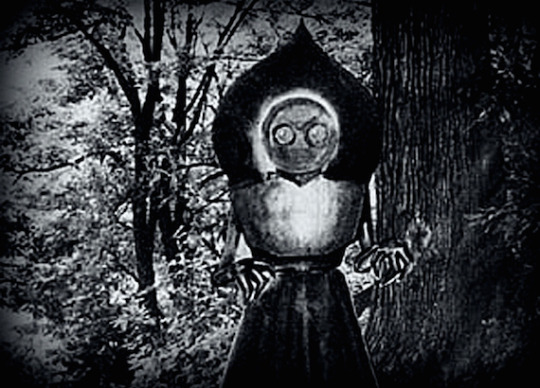
The setting for this very bizarre tale is the small rural town of Flatwoods in Braxton County, West Virginia. It is a quiet town pretty much in the middle of nowhere, where everyone knows each other and not much typically happens, but on September 12, 1952, all that would change, and the peace would be disrupted by a world changing event for them. On this evening, at around 7:15 PM, brothers Edward and Fred May were outside playing a friendly game of football when they were surprised to see what looked like a pulsating, blazing ball of fire go streaking across the sky to come down and seemingly crash in some hilly woods at a nearby farm owned by a G. Bailey Fisher.
Not quite believing what they had just witnessed, the excited boys ran to the house of a neighbor named Kathleen May, to whom they breathlessly told of what they had seen. May gathered up a flashlight and called together a group of people composed of local children Neil Nunley and Ronnie Shaver, as well as 17-year-old West Virginia National Guardsman Eugene Lemon, to go investigate the area where the strange ball of fire had gone down, along with Lemon’s dog. As they followed the beam of the flashlight out into the night past the dancing, flickering trees they still had no idea what they were dealing with or what to expect out there, and there was a sense of apprehension and even fear as they stumbled along up a hill on the farm. Little did they know that things were about to get very bizarre indeed.
When they reached the top of the wooded hill they could see through the trees what seemed to be a pulsating red light, and they were overcome by a sudden, nauseating metallic stench that they would later describe as a “pungent mist.” In the meantime, the dog snarled and barked before retreating with its tail between its legs, leaving them stabbing about in the darkness with the flashlight beam, searching for whatever it was that had chased the animal away. As they peered through the darkness trying to make out just what the light ahead was and what lie out there in the gloom, they could see glinting in the light of the flashlight what looked like the shining eyes of some nocturnal animal, but it soon became apparent that this was no animal any of them had ever seen before.
The mysterious eyes seemed to be set within a massive humanoid figure standing around 10 feet tall, with a round, fiery red face with glowing yellow eyes set within it, framed in some sort of hood or cowl shaped like “the ace of spades” embedded with flickering lights, and possessing small clawed hands, and a dark green, possibly black cylindrical body with what appeared to be folds upon it like some sort of draped fabric or molded metal, the whole of which was wreathed in some mist or fog. None of them got much of a chance to examine it for too long, because after a few moments whatever the entity was emitted “something between a hiss and a high-pitched squeal,” and then glided right towards them with a “thumping, throbbing noise” to send the terrified witnesses running for their lives down the hill, dropping the flashlight in the process to send them into near total darkness. Upon returning home they would all experience severe nausea, swelling of the throat, and even convulsions, compared with the symptoms of mustard gas by the doctor who examined them.
The next day, local law enforcement checked out the site of the purported incident, but were unable to find any corroborating evidence for anything the group said they had seen. There was no trace of any pulsing light, no sign of the creature or its odiferous stench, and nothing at all to suggest anything out of the ordinary. That was the official consensus, but of course word got out and it was not long at all before the media was stoking the fires of UFO rumors by claiming that signs of a landing, such as “skid marks” and an “odd, gummy deposit,” as well as strange pieces of a plastic like material, had been found at the scene by a reporter named A. Lee Stewart, Jr., and it was also discovered that numerous people in the area had also seen an object streak across the sky on the night in question. The case took off as a real UFO landing, and the media went with it, splashing it all over newspapers as various UFO enthusiasts and paranormal investigators descended on the area as well, including esteemed Fortean writers Gray Barker, Ivan T. Sanderson, and John Keel arriving to investigate.
Various strange accounts began to come out of the woodwork at the time, such as one woman who claimed to have seen the same monster that had been described just a few weeks before, and another witness who said that her house had reverberated and been shaken by some mysterious force on the night in question. Another report came from a couple who claimed that just hours after the original sighting they had been driving down the highway when they had noticed a horrible metallic smell and been assaulted with what felt like an electrical charge, before witnessing an otherworldly reptilian creature float across the road in front of them.
There were other odd accounts as well. Mrs. May would claim that the day after the incident she had been approached at her home by two mysterious men who said they were reporters and had asked to be shown the site, after which they would emerge from the trees with strange oily stains on their clothes. In later years even more strange accounts would surface, such as a commander of the West Virginia National Guard named Captain Dale Leavitt, who in the 1990s would say that he had examined the area with 50 Air Force personnel after the “crash” and find an oily substance and a mysterious “6m circle of depressed grass.”
There would also turn out to have been numerous other sightings of UFOs on the night of September 12 across several states. Indeed, in an account compiled by investigator Frank Feschino, Jr. in 2004, there would be hundreds of reports of unidentified flying objects and landings reported on from the same night as the incident. Adding to all of this were the odd physical symptoms reported by the witnesses and their doctors, as well as the subsequent strange death of the dog who had been with them, which allegedly began vomiting uncontrollably and dropped dead for no clear reason. All things told, the weird incident sparked UFOmania in the small rural town, and many were convinced that what had been seen was an actual alien spacecraft landing and its unearthly occupant. Indeed, Ivan T. Sanderson was sure that this was the case, and that the numerous other UFO reports from the same time frame implied perhaps a whole fleet of the objects passing the area.
In the years after the Flatwoods encounter the original witnesses would stick by their story, insisting on what they had seen, and it became one of the most famous alien encounters in the annals of the paranormal. So what was it they saw out there? What was that light, the noxious odor, and indeed that looming, glowing eyed beast? What connection did this have to the lights that so many people saw shooting across the sky on that same exact evening? Just what is going on with the case of the Flatwoods Monster? That depends a lot on who you ask.
A very persuasive skeptical argument is that the whole mysterious event is the result of a unique convergence of a mixture of misidentification and coincidence. In this theory the light, or lights as the case is often described, was perhaps a meteor, which was mistakenly thought to have crashed behind that wooded hill by the witnesses. There were indeed many people who reported the light seen as not a UFO, but as a meteor, so perhaps the witnesses saw this celestial event and jumped to a different conclusion. They then warily went up that dark hill in a state of fear, the atmosphere made more ominous by a blanket of fog that was covering the area at the time. In this state of dread, they saw one of the three aircraft warning hazard beacons in the area visible from that hill, and considering the meteor they had seen mistook it for a UFO.
But what about the horrible monster they saw, you ask? The skeptical take on it is that this was no monster at all, but rather a large barn owl perched atop a high branch. In the murky darkness, with fear pervading the air and low visibility and that sinister light visible through the trees, the witnesses misidentified the owl and its perch as being part of a single entity. The owl, just as startled as the witnesses, had then flown off past them into the night, letting out one of the bird’s distinctive shrill cries in the process. In their panic and surprise, the witnesses had mistaken it for an alien entity flying towards them, sending them running. Many of the features of a barn owl match up with the description of the creature, and looking at artistic representations comparing the monster and an owl it is easy to see the similarities, especially considering that they had only seen it fleetingly for a few moments in dim lighting before fleeing in terror.
This all seems to make sense so far, but then we are left to ask just what about the other evidence found, such as the oily residue and the strange track marks? Some have pointed out that these tracks could have been caused by a tractor that was in the area at around the time of the sighting, the oil perhaps leaking from it, or even from the truck of a local man who had gone driving through hoping to see the creature. The foul odor had been suggested as being exuded by a type of grass native to the area with a distinctive smell. And the negative physical symptoms are claimed by skeptics to have been simply caused by deep fear and over exertion. Skeptic Joe Nickell wrote a whole deconstruction of the case for the Skeptical Enquirer, which you can read here, and it is so convincing that even many paranormal researchers and UFOlogists have conceded that this is probably what actually happened.
Joe Nickell’s sketch comparing a barn owl and the alleged “monster”
It certainly seems to be open and shut when looking at all of the clues and evidence that this may have just been one big misunderstanding seen through the lens of anxiety and fear, later sensationalized by the media and embellished with countless books and articles in the lore of the paranormal. Yet there are many who think that the case is far from solved, pointing out that there are still aspects that don’t fit in neatly with the skeptical theory, such as the pulsing quality of the “meteor” and the fact that a whole group of people saw the creature and maintained that it was no owl.
Whatever the answer may be, whether this was some alien entity or the product of misidentification and overactive imaginations, the tale of the Flatwoods Monster still gets plenty of play in paranormal circles, and is still talked about and debated to this day. It has become such a legendary case that the town of Flatwoods has a museum dedicated to the creature and an annual weekend festival to commemorate it called “Flatwoods Days,” which features live music, and food and craft vendors. There is even a sign on the road leading into town that reads “Welcome to Flatwoods / Home of the Green Monster,” so it seems that whatever the Flatwoods Monster was or wherever it went, it has been ingrained in the town’s culture and in the world of Forteana, and in a sense is here to stay.
41 notes
·
View notes